Leaf springs are a critical component in the suspension system of many vehicles, especially in trucks and larger automobiles. They play a vital role in providing support, maintaining a comfortable ride, and handling the load of a vehicle. Measuring leaf springs accurately is essential for replacement, repair, or customization.
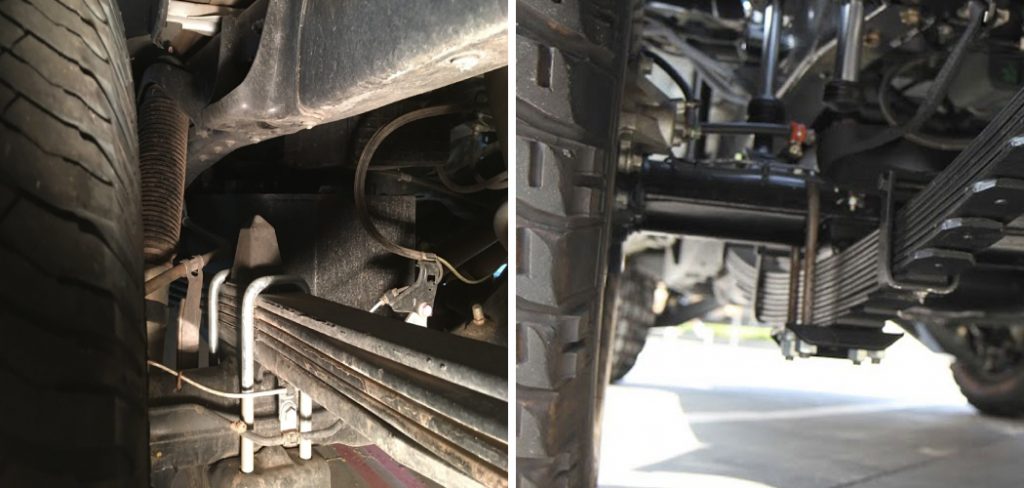
It ensures that the springs fit perfectly, maintain the correct vehicle height, and contribute to the vehicle’s overall safety and performance. In this guide, we will walk through the process of how to measure leaf springs correctly to make an informed decision when it comes to purchasing or modifying this significant part of your vehicle’s suspension system.
What is a Leaf Spring?
A leaf spring is a long, curved piece of metal typically made from heat-treated steel. It can also be made from composite materials such as fiberglass or carbon fiber for high-performance vehicles. The primary function of a leaf spring is to absorb and distribute the weight of a vehicle evenly, preventing it from sagging or bouncing excessively.
Leaf springs work by compressing and expanding as the vehicle moves, providing a stable base for the suspension to operate efficiently. They are commonly used in the rear suspension of trucks and trailers and can also be found in some front suspensions.
Why Measure Leaf Springs?
As with any mechanical component, leaf springs can wear out over time and require replacement. However, proper measurement is crucial to ensure the new springs match the old ones in terms of length, width, and load capacity.
Installing incorrect or mismatched leaf springs can cause handling issues, affect the vehicle’s ride height and compromise its overall safety. Additionally, measuring leaf springs is necessary when customizing a vehicle’s suspension, such as lifting or lowering it. Accurate measurements allow for proper adjustments and ensure that the vehicle’s handling remains balanced.
Tools Required
To measure leaf springs accurately, you will need a few tools at your disposal, including:
Measuring Tape or Ruler
A measuring tape or ruler is necessary to measure the length and width of the leaf springs accurately. It should be long enough to measure the full length of the spring, from one end to the other.
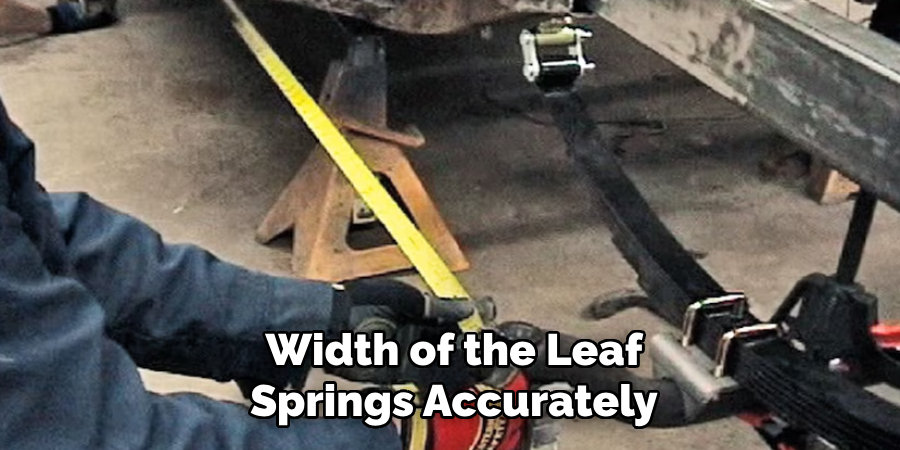
Digital Caliper
A digital caliper is a precision instrument used for taking accurate measurements down to a fraction of a millimeter. It is incredibly useful when measuring the thickness and width of leaf springs.
Spring Center Bolt
A spring center bolt is a tool used to align the leaves of a leaf spring accurately. It helps ensure that all the leaves are in their correct positions, making measurement easier and more accurate.
12 Step-by-step Instructions on How to Measure Leaf Springs
Step 1: Identifying the Need for Leaf Spring Measurement
Before beginning the measurement process, determine why you need to measure your leaf springs. If you are replacing old ones with new ones, ensure that the replacement leaf springs match the originals in length, width, and load capacity. It is also essential to measure leaf springs if you are planning on customizing your vehicle’s suspension.
You may also need to measure the springs if you suspect they are damaged or worn out and require replacement. The reason for measurement will also determine the type of measurements you need to take. But generally, you will need to measure the length, width, thickness, and number of leaves in your leaf springs.
Step 2: Selecting the Right Tools for Measurement
As mentioned earlier, you will need a measuring tape or ruler, a digital caliper, and a spring center bolt to measure your leaf springs accurately. Ensure that the tools you have are suitable for taking precise measurements. The measuring tape or ruler should be long enough to measure the full length of the springs.
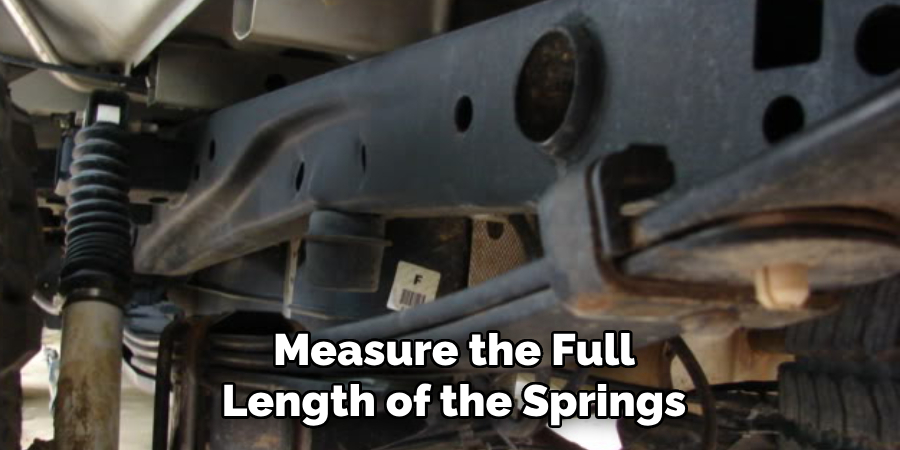
The digital caliper should have a precision level of at least 0.001 inches for accurate thickness and width measurements. It is also essential to have a spring center bolt that fits your leaf springs. The right tools will make the measurement process more manageable and help you get accurate results.
Step 3: Safety Precautions Before Measuring
Before beginning the measurement process, make sure that your vehicle is on a level surface and turned off. The ground should be stable enough to support the weight of the vehicle without any movement. Engage the parking brake for added safety and ensure that there are no objects or obstructions near the springs.
It would also be helpful to wear appropriate personal protective equipment, such as gloves and safety glasses, to protect yourself from the metal components. The leaf springs can be sharp and cause injury if not handled carefully.
Step 4: Measuring the Length of the Leaf Spring
Using the measuring tape or ruler, measure the full length of the leaf spring from one end to the other. Place one end of the measuring tape at the center bolt and extend it to the opposite end. Make sure that the tape is straight and not kinked in any way for accurate measurements.
Note down this measurement as it will be necessary when purchasing replacement springs. But if you are customizing your suspension, take measurements before and after the changes to ensure that the new length is suitable for your specific needs. The length of leaf springs is typically measured in inches.
Step 5: Calculating the Arch or Bow of the Leaf Spring
The arch or bow of a leaf spring is the curved shape that allows it to compress and expand as weight is added or removed from the vehicle. It is crucial to know the amount of arch in your springs for proper installation and alignment.
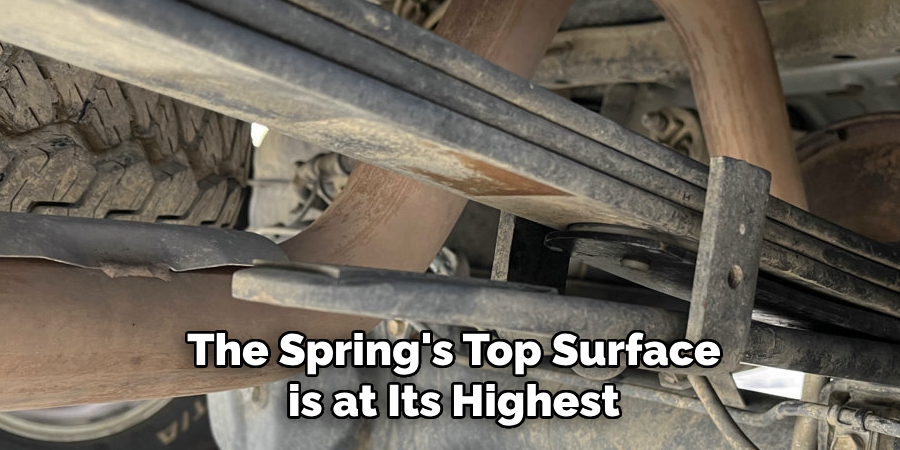
To measure this, place one end of the measuring tape at the center bolt and extend it to the point where the spring’s top surface is at its highest. This measurement will be the arch or bow of your leaf spring. It is typically measured in inches.
Step 6: Determining the Width of the Leaf Spring
To measure the width of a leaf spring accurately, use a digital caliper. Place the caliper’s jaws on the top surface of the leaf, close to one end, and take a reading of its width. Repeat this process at multiple points along the length of the leaves for more accurate results as leaf springs can taper towards their ends.
Note down the widest measurement as this will be the width of your leaf spring. It is typically measured in inches. The width of the leaves is essential as it determines how much weight they can support. It is also crucial to have equal widths for all the leaves in a leaf spring pack.
Step 7: Identifying the Number of Leaves in the Leaf Spring Pack
Count the number of leaves in your leaf spring pack. It is necessary to know this information when purchasing replacement springs or customizing your suspension. Note down the number for future reference. The number of leaves is typically between three to ten, depending on the vehicle’s weight and load capacity. The more leaves a spring has, the higher its load capacity and stiffness.
Step 8: Measuring the Thickness of the Leaf Springs
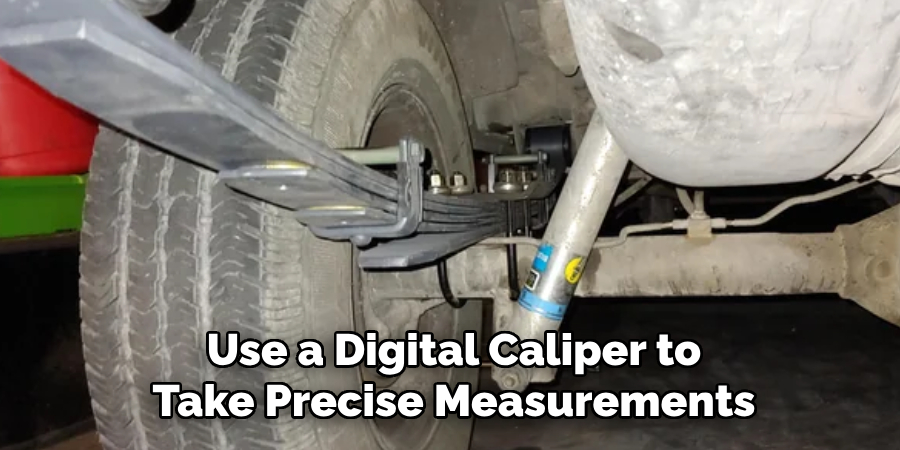
The thickness of leaf springs is crucial as it determines their load-carrying capacity and flexibility. Use a digital caliper to take precise measurements of the thickness. Place the caliper’s jaws at various points along the width of each leaf and take readings. Note down the thickest measurement as this will be the thickness of your leaf springs.
It is typically measured in inches. It is also essential to measure the thickness of all leaves in a pack and ensure they are equal. Any significant differences could indicate damage or wear on a particular leaf. The thickness will also help you determine the type of leaf spring you have, as different types have varying thicknesses.
Step 9: Identifying the Number of Leaves in Each Leaf Spring Layer
Some leaf springs have multiple layers, with smaller leaves stacked on top of the larger ones. In this case, it is crucial to know the number of leaves in each layer as it can affect the spring’s overall flexibility and load capacity. Use a digital caliper to measure the thickness of each layer individually and count the number of leaves in each layer.
Note down this information for future reference. It will be necessary when purchasing replacement springs or customizing your suspension. The number of leaves in each layer is typically between two to four, depending on the leaf spring’s design.
Step 10: Measuring Eye Diameter and Bushing Length
The eye diameter and bushing length are essential measurements for leaf springs with an eye or shackle at each end. The eye diameter is the size of the hole in the bushing, while the bushing length is the distance between both eyes when they are closed.
To measure these accurately, use a digital caliper to take readings at multiple points along their lengths. Note down the measurements for future reference. It will be necessary when purchasing replacement springs or customizing your suspension.
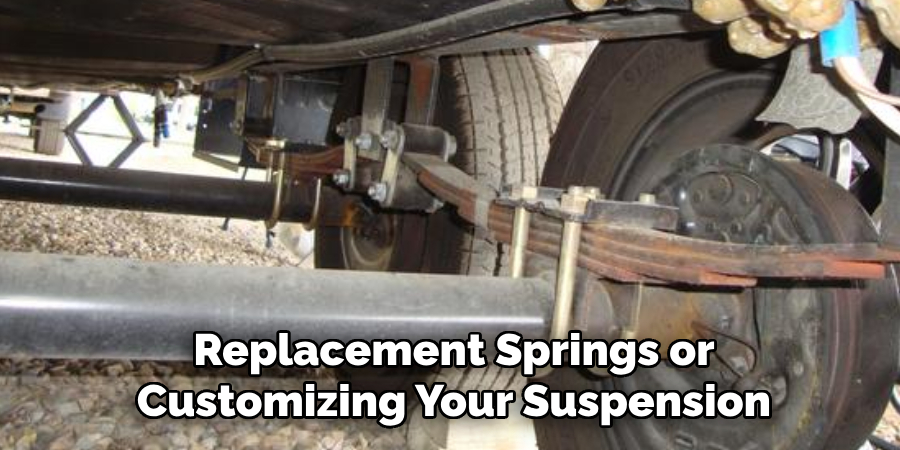
Step 11:Checking the Thickness of Each Leaf’s Center Bolt
The center bolt is an important component of leaf springs as it holds all the leaves together. It is essential to check its thickness to ensure it can handle the weight and pressure applied by the spring pack. Use a digital caliper to take precise measurements at multiple points along the length of the center bolt, including its thread diameter and shank diameter.
Note down these measurements for future reference and compare them with the manufacturer’s specifications. If they are significantly different, consider replacing the center bolt to maintain optimal safety and performance.
The thickness of the center bolt is typically measured in inches. It is also essential to check for any signs of wear or damage, such as corrosion or bending, which can affect the spring’s overall performance. Regularly inspecting and maintaining your leaf springs can help prevent costly repairs and ensure your vehicle’s safety on the road.
Step 12: Assessing Load Capacity and Spring Rate
After gathering all the necessary measurements, you can now determine your leaf spring’s load capacity and spring rate. The load capacity refers to the maximum weight a leaf spring can support without failing, while the spring rate is the amount of force required to compress or expand the spring by one inch.
These numbers are crucial when purchasing replacement springs or customizing your suspension as they must match your vehicle’s weight and usage. Consult a professional or refer to manufacturer specifications for more accurate load capacity and spring rate calculations.
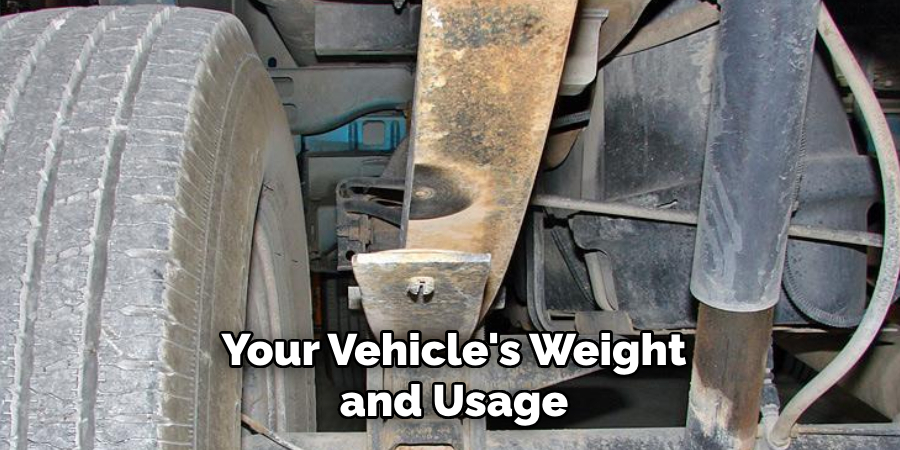
Following these steps on how to measure leaf springs and taking accurate measurements will help you understand your leaf springs better. This knowledge will be crucial when it comes to maintaining, upgrading, or customizing your vehicle’s suspension system.
Remember to always consult a professional if you are unsure or inexperienced in handling leaf springs. Proper installation and alignment are crucial for optimal performance and safety on the road.
Documenting and Recording Measurements
It is essential to document and record all the measurements taken during the leaf spring measuring process. Keeping a detailed record of these measurements will make it easier to reference them in the future when purchasing replacement springs or customizing your suspension. It also allows for easier comparison with manufacturer specifications, ensuring that you have the correct measurements for your specific vehicle.
There are various ways to document and record these measurements, such as using a notebook or spreadsheet. Whichever method you choose, make sure to include all the necessary measurements related to your leaf springs’ width, number of leaves, thickness, eye diameter and bushing length, and center bolt dimensions.
Seeking Professional Assistance
If you are unsure or inexperienced in handling leaf springs, it is always best to seek professional assistance. A certified mechanic or suspension specialist will have the knowledge and tools to accurately measure your leaf springs and provide recommendations for replacements or customization based on your vehicle’s specifications.
Remember, proper installation and alignment of leaf springs are crucial for optimal performance and safety on the road. So, if you are not confident in your abilities, it is best to leave it to the professionals. It may cost a bit more, but it will ensure that your vehicle’s suspension system is functioning correctly and can handle the weight and demands placed on it.
Overall, properly measuring your leaf springs and seeking professional assistance when needed will help keep your vehicle running smoothly and safely. So, don’t skip this important step in maintaining you vehicle’s suspension system. It will save you time and money and ensure your safety on the road. Happy measuring!

Frequently Asked Questions
Q: How Often Should I Measure My Leaf Springs?
A: It is recommended to measure your leaf springs at least once a year or before any long road trips, especially if you use your vehicle for heavy-duty hauling or towing. The measurements can change over time due to wear and tear, so regular checks will ensure optimal performance and safety. You should also measure your leaf springs if you notice any changes in your vehicle’s ride quality or handling.
Q: Can I Repair a Damaged Leaf Spring Instead of Replacing it?
A: It is not recommended to repair a damaged leaf spring as it can compromise its load capacity and structural integrity. A damaged leaf spring should be replaced entirely to ensure optimal performance and safety on the road.
Q: Can I Install Different Types of Leaf Springs on My Vehicle?
A: It is not recommended to mix different types of leaf springs on a vehicle as it can affect its ride quality, handling, and overall performance. Stick to the same type and specifications for all leaf springs in your vehicle’s suspension system. However, you can customize your suspension by choosing different types of leaf springs that match your vehicle’s weight and usage.
Q: Can I Measure My Leaf Springs Without a Digital Caliper?
A: While a digital caliper is the most accurate tool for measuring leaf springs, you can also use a ruler or tape measure. However, the measurements may not be as precise, so it is recommended to use a digital caliper for more accurate results. If you do not have access to a digital caliper, consider taking your leaf springs to a professional for measurement.
Conclusion
In conclusion on how to measure leaf springs, measuring leaf springs accurately is crucial for the maintenance of your vehicle’s suspension system. Understanding the different measurements required, such as free length, arch height, and leaf width, is essential for both identifying the correct replacement springs and ensuring a smooth installation process.
Regular checks and replacements will help maintain the integrity of your vehicle’s suspension, providing a comfortable ride and preventing potential damage to the vehicle. Always refer to the manufacturer’s specifications for precise measurements to ensure optimal performance and safety.

About
JeepFixes Team is a skilled author for Jeep Fixes, bringing 6 years of expertise in crafting a wide range of jeep fixes. With a strong background in jeep fixes work, JeepFixes Team’s knowledge spans various types of fixtures, from decorative pieces to functional hardware, blending precision with creativity. His passion for jeep fixes and design has made him a trusted resource in the industry.
Professional Focus:
Expert in Jeep Fixes : JeepFixes Team aesthetic specializes in creating durable and innovative jeep fixes, offering both appeal and functionality. His work reflects a deep understanding of jeep fixes techniques and materials.
Sustainability Advocate : He is dedicated to using sustainable practices, ensuring that every fixture is crafted with eco-friendly methods while maintaining high-quality standards.
In his writing for jeep fixes, JeepFixes Team provides valuable insights into the latest trends, techniques, and practical advice for those passionate about jeep fixes, whether they are professionals or DIY enthusiasts. His focus on combining artistry with engineering helps others discover the true potential of jeep in design.
